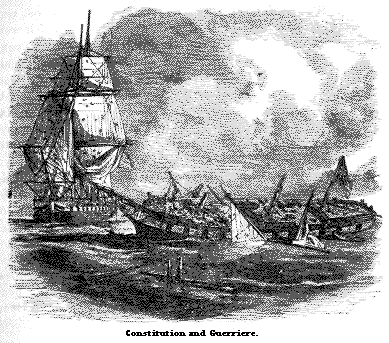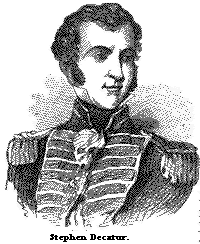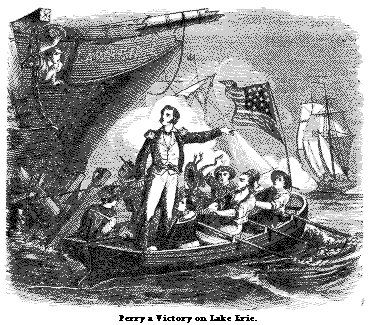Resource Center OLLibrary
|
174 |
|
Hull crossed into
Canada with about two thousand men, intending to attack Fort
Malden; but learning that the fort bad been reënforced, that
reënforcements and supplies sent from Ohio had been
![]() cut off,
and that Mackinaw, a strong post on which he had relied to keep
the northern Indians in check, had been surprised by a party of
savages and English, and had surrendered, he abandoned the
enterprise without striking a blow. Brock pursued him into
Michigan, with about fourteen hundred men, nearly half of whom
were Indians.
cut off,
and that Mackinaw, a strong post on which he had relied to keep
the northern Indians in check, had been surprised by a party of
savages and English, and had surrendered, he abandoned the
enterprise without striking a blow. Brock pursued him into
Michigan, with about fourteen hundred men, nearly half of whom
were Indians.
5. Hull's disaster did not prevent
another attempt to invade Canada. General Stephen Van Rensselaer,
who commanded a body of Americans on the Niagara frontier, sent a
party across the liver, October 13, to attack the British at
Queenstown Heights. The invaders gained possession of a
battery on the bank, but at length were compelled to surrender,
the enemy having been reënforced, and many of the American
militia refusing to cross over to aid their countrymen.
The Americans lost, in killed, wounded,
and prisoners, more than a thousand. About one hundred of the
British were killed, among whom was General Brock, their
commander. Among the Americans who distinguished themselves were
Lieutenant-Colonel Winfield Scott1 and Captain John
Ellis Wool,2 who were taken
prisoners.
6. Fort Dearborn,3 by
order of General Hull, was evacuated the day before his surrender.
The sound of war was heard all along the northern frontier,
and the report of loss and disaster was lightened by tidings of no
important American success.
General Harrison,4 at the head
of volunteers, chiefly from Kentucky, attempted to recover
Detroit, but accomplished nothing. General Smyth, who succeeded
Van Rensselaer, attempted an invasion of Canada from Buffalo,
which resulted only in giving the British a few more prisoners.
General Brown,5 in command of the militia of Northern
New York, repelled an attack on Ogdensburg. In the mean time
General Dearborn,6 with his immediate command, had
reached the frontier by way of Lake Champlain; but, like the rest,
he effected nothing towards the conquest of
Canada.7
7. From disasters on land the Americans
turned for encouragement to the exploits of their little
navy, which was, almost without exception, successful on
the ocean. Captain David Porter, in the frigate Essex,
began that series of
1 See p. 214, § IV., and p. 246, ¶ 13. 2 See p. 211, ¶ 1, and p. 267, ¶ 29. 3 Now Chicago.
4 See p. 169, ¶ 1. One of Harrison's bravest officers was Captain Zachary Taylor (see p. 208, ¶ 4, and p. 219.) 5 See p. 182, ¶ 27. 6 See p. 171, ¶ 1. 7 See p. 176, ¶ 9.
QUESTIONS. -- What further particulars of the invasion of Canada can you give? 5. Give an account of the attack upon Queenstown Heights. 6. What is said of Fort Dearborn? Of the war along the northern frontier? -- What is said of General Harrison? General Smyth? General Brown? General Dearborn? 7. What is said of the exploits of the American navy? Of Captain Porter and the Essex?
|
|
175 |
American naval achievements for which the war
was distinguished, by dashing into a British convoy and cutting
out a transport filled with troops; August 13, he captured the
British Sloop of war Alert. On the 19th Captain Isaac Hull,
of

the United States frigate Constitution,1 encountered the frigate Guerriere, off the Gulf of St. Lawrence, and after a brief engagement compelled her to surrender. The British ship was so much damaged that the victors burned her. The Constitution was but slightly injured. Next followed, October 18, off the coast of North Carolina, a victory gained by the sloop of war Wasp, Captain Jacob Jones, over the British brig Frolic. In the afternoon of the same day both vessels were taken by the English seventy-four Poictiers. Just one week elapsed, when Commodore Stephen Decatur,2 in the frigate United States, cruising south of the Azores.3 captured the English frigate
1 Familiarly known as Old Ironsides. 2 See p. 167, note 1.
3 Islands in the Atlantic Ocean, about three-fourths of the way from Virginia to Spain.
QUESTIONS .-- What is said of Captain Hull and the Constitution? Of Captain Jones and the Wasp? Commodore Decatur and the United States?
|
176 |
|
Macedonian. The last naval triumph of
this year was the capture, December 29, off Brazil, of the British
frigate Java, by the Constitution, then commanded by
Commodore William Bainbridge.1 Before the close of the
year more than three hundred prizes had been taken by American
ships of war, and by privateers, which were preying upon British
commerce in every  sea.
Meanwhile naval armaments were in preparation on the lakes, to aid
in the conquest of Canada.2
sea.
Meanwhile naval armaments were in preparation on the lakes, to aid
in the conquest of Canada.2
8. In the autumn of this year the people
of the United States set the seal of their approval on the war, by
reëlecting Mr. Madison president by a large majority.
Elbridge Gerry, of Massachusetts, was chosen
vice-president.
9. Events of 1813. -- At the beginning of
1813, the American forces on the northern
frontier3 were divided into three armies: the
Army of the West, under General Harrison, near the head of
Lake Erie; the Army of the Centre, under General Dearborn,
on the Niagara frontier; and the Army of the North, under
General Wade Hampton,4 near Lake Champlain.
10. In January, General James Winchester
advanced to the Maumee Rapids,5 with a portion of the
Army of the West, consisting of about eight hundred men,
chiefly from Kentucky. He sent forward a detachment, which routed
a body of Indians and British at Frenchtown, on the River
Raisin, and soon followed with the rest of his force. Early in the
morning of the 22d, he was attacked by a large number of British
and Indians, under Colonel Proctor, and forced to surrender.
1 See p. 167, note 1. 2 See p. 180. ¶ 22. 3 See pp. 171, 4.
4 see p. 180, ¶ 19. 5 Near Perrysburg.
QUESTIONS. -- What is said of Commodore Bainbridge and the Constitution? Of American ships of war and privateers? Of naval armaments on the lakes? 8. In the autumn how did the people show their approval of the war? Who was chosen vice-president? 9. How were the American forces on the frontier divided at the beginning of 1813? Name the commanders of each division. 10. Give an account of the battle at Frenchtown.
|
|
177 |
Proctor promised to
protect his prisoners from the Indians, but marched sway, leaving
the wounded to the mercy of his savage allies, who fell upon them
and perpetrated the most inhuman butcheries. By this bloody
tragedy all Kentucky was thrown into mourning, and "Remember the
Raisin," became the war-cry of her sons.
11. At the time of this disaster,
Harrison was on his way to aid Winchester. Learning of the
surrender at Frenchtown, he established a post at the
Rapids,1 and named it, in honor of the governor of
Ohio, Fort Meigs. Here, about the first of May, he was
besieged by a large force of British and Indians under Proctor.
But the siege was raised in a few days by the arrival of
reënforcements from Kentucky, under General Greene Clay. Two
months later Proctor again advanced upon the fort, but soon
relinquished his designs upon that post, and proceeded against
Fort Stephenson, at Lower Sandusky,2 garrisoned
by one hundred and fifty men, under Major George Croghan, then but
twenty-one years old. To a summons to surrender, the gallant major
replied, that he would defend the fort to the last man. The
British and their allies made a vigorous onset, but were driven
back with great loss, the Indians, as usual, deserting at the
first repulse.
12. The enemy yet held
Michigan and Lake Erie, and threatened Ohio; but a different face
was put upon affairs in that quarter by Perry's victory on
Lake Erie. On the 10th of September, Captain Perry, -- with a few
vessels, encountered the British squadron, under Captain Barclay,
off Sandusky, and the result was a complete victory for the
Americans, "We have met the enemy, and they are ours -- two ships,
two brigs, one schooner, and one sloop," was Perry's laconic
report to General Harrison.
Commodore Isaac Chauncey,3 who
had been appointed to the command of the lakes, and who had
already achieved some successes on Lake Ontario, sent Captain
Oliver Hazard Perry to prepare a fleet and command it on Lake
Erie. At Erie, a port in Pennsylvania, Perry fitted out his
squadron -- nine vessels, carrying fifty-five guns. The enemy had
six vessels with sixty-tbree guns. Each fleet had about five
hundred men. The fight began near noon. Compelled to abandon his
flag-ship, the Lawrence, which had been completely disabled by the
concentrated fire of the British fleet, Perry took to a boat, and
through a storm of shot transferred his flag to another ship. Then
breaking through the line of the enemy, he poured into their
vessels a succession of broadsides with such terrific effect that
the whole fleet surrendered.
1 See p. 1743, ¶ 10. 2 Now Fremont. 3 See p. 179, ¶¶ 16, 18.
QUESTIONS. -- What is said of the treatment of prisoners by the Indians? 11 What fort did Harrison erect, and where? Give an account of Proctor's attempts upon this fort. Of his attempt upon Fort Stephenson. 12. Give an account of Perry's victory on Lake Eric. -- Who had been appointed to the command of the lakes? Give further particulars of the battle.
|
178 |
|

13. Harrison hastened
to profit by this victory. Embarking, is troops on board the
fleet, he crossed to Canada, and advanced upon Malden, only to
![]() find that
the enemy had retreated. The Americans, pursuing, overtook Proctor
at the Moravian town on the Thames, and gave battle,
October 5. Nearly all of Proctor's command were captured; a few
were killed; Proctor himself escaped with a small guard.
Tecumseh,1 who had for years been the chief instigator
of Indian difficulties in the north-west, was slain.
find that
the enemy had retreated. The Americans, pursuing, overtook Proctor
at the Moravian town on the Thames, and gave battle,
October 5. Nearly all of Proctor's command were captured; a few
were killed; Proctor himself escaped with a small guard.
Tecumseh,1 who had for years been the chief instigator
of Indian difficulties in the north-west, was slain.
At the beginning of the battle, Colonel
Richard M. Johnson,2 with his regiment of mounted
Kentuckians, made a furious charge, from which the British could
not recover. The Indians fought bravely till Colonel Johnson's
pistol took off Tecumseh, when his savage followers
fled.3
14. By this victory Ohio was saved,
Michigan, except the extreme north, regained, Indian hostilities
were suppressed, and the work of the Army of the West was
completed. General
1 See p. 170, ¶ 1.
2 Afterwards vice-president (see p. 201, ¶ 16)
3 In this battle. were retaken six field-pieces which had been surrendered by Hull (see p. 171, ¶ 4). On two of them was the inscription, "Surrendered by Burgoyne, at Saratoga."
QUESTIONS. -- 13. How did Harrison profit by this victory? Give an account of the battle on the Thames. What is said of Colonel Johnson? 14. Result of this battle?
|
|
179 |
Harrison sent home his volunteers, and, leaving
General Lewis Cass1 with a strong garrison for Detroit,
embarked with the rest of his regulars for Buffalo, to join the
Army of the Centre.2 Harrison soon afterwards resigned
his commission.
15. The Armies of the Centre and the
North2 accomplished but little this year.
York,3 the capital of Upper Canada, was captured, but
soon abandoned; Fort George, and all the British posts on the
Niagara, were occupied by the Americans, who, however, before the
end of the year, were not only compelled to relinquish them, but
also to surrender the forts on the American side of the river.
16. Late in April General
Dearborn2 embarked from Sackett's Harbor, with
seventeen hundred men, on board the fleet of Commodore
Chauncey,4 for the purpose of attacking York,
the great depository of British military stores. On the 27th a
landing was effected, Colonel Scott, who had recently been
exchanged,5 leading the van. General Pike, to whom was
intrusted the command, immediately led his troops to the assault.
They met with but little resistance. The enemy fled, and the town
capitulated, but not before two hundred Americans were killed or
wounded by the explosion of a magazine. The brave General Pike was
mortally wounded.
17. One month later, May 27, the
fleet and army proceeded against Fort George. A landing was
effected under the gallant Scott. The British abandoned the fort,
and fled towards the head of the lake. A detachment of Americans,
under Generals John Chandler and William Henry Winder, was sent in
pursuit of the enemy. At Stony Creek the British made a night
attack, June 6, upon their pursuers, and though repulsed with
considerable loss, both the American generals fell into their
hands. Another detachment of six hundred men, ordered to disperse
a body of the enemy at the Beaver Dams,6 was
surrounded and compelled to surrender, June 24. After the fall of
Fort George all the British forts on the Niagara were speedily
evacuated.
18. To collect troops for
his enterprise against Fort George, Dearborn had weakened the
posts on Lake Ontario. Sir George Prevost, the British
commander-in-chief in Canada, seized this opportunity to make a
descent upon Sackett's Harbor, May 29. The British, though
repelled by General Brown,7 succeeded in getting
command of the lake, and kept the Americans in a state of
inactivity for the whole summer. At length Commodore Chauncey,
after an indecisive action off York, September 28, drove the
enemy's fleet into Burlington Bay, and held it there for some time
blockaded.
1 See p. 229, ¶ 15. 2 See p. 176, ¶ 9. 3 Now Toronto. 4 See p. 177, ¶ 12.
5 see p. 174, ¶ 5. 6 A few miles westerly from Queenstown. 7 See p. 174, ¶ 6.
QUESTIONS. -- How did General Harrison dispose of his army? 15. What is said of the armies of the centre and the north? Of York? Of Fort George and the British posts on the Niagara? 16. Give some particulars of the capture of York. 17. Of the capture of Fort George. Of the affair at Stony Creek? At Beaver Dams? 18. What is said of the attack on Sackett's Harbor? Of the Americans on the lake during the summer? What was done by Commodore Chauncey?
|
|
|
|
|
|
© 1999, 2000, 2001 for NEGenWeb Project by Ted & Carole Miller